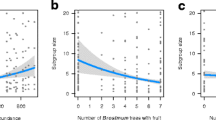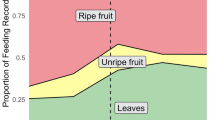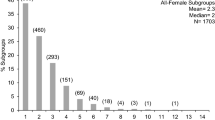Abstract
Fission-fusion dynamics (FFD) encompass a behavioral strategy present in many animal species that reduces the costs and increases the benefits of group living. In this case study, we investigated how group characteristics (size and composition) and fission rates in spider monkeys varied in space and time with rainfall, fruit availability, and fruit variability in two sites, each presenting different characteristics regarding the distribution and size of food patches and rainfall. Habitat characteristics strongly influenced FFD in spider monkeys, particularly subgroup size and fission rate. Subgroup size varied with fruit availability and its variability, while fission rates varied with rainfall and fruit variability. However, both subgroup size and fission rate varied in opposite ways, depending upon habitat type. Subgroups tended to present stable mixed-sex composition regardless of fruit availability. We conclude that for spider monkeys, FFD are part of a flexible behavioral strategy to cope with a locally fluctuating environment and with different environments within the geographic range of the species.
Significance statement
Fission-fusion dynamics (FFD) constitute a form of social organization that allows some species to take advantage of living in groups under different environmental conditions. The relationship between social organization and environmental variables has been well studied, but inconsistencies remain. One potential reason for these inconsistencies may be the focus of most studies on a single habitat type, with few formal comparisons of FFD in the various habitats occupied by a species. We evaluated how habitat characteristics (e.g., food availability and rainfall) affect FFD (assessed through subgroup size, subgroup composition, and fission rate) in spider monkeys (Ateles geoffroyi) in two different habitat types. We found that within a single habitat type, food availability, variability, and rainfall affected subgroup size and fission rate. Crucially, these relationships contrasted sharply, depending on habitat type. Our study shows that FFD are flexible within and across habitats, indicating the importance of considering habitat characteristics when conducting socio-ecological observations. We caution against generalizations based upon single-habitat studies.



Similar content being viewed by others
Data availability
The datasets analyzed during the current study are available from the corresponding author on reasonable request.
References
Asensio N, Korstjens AH, Aureli F (2009) Fissioning minimizes ranging costs in spider monkeys: a multiple-level approach. Behav Ecol Sociobiol 63:649–659. https://doi.org/10.1007/s00265-008-0699-9
Aureli F, Schaffner CM, Asensio N, Lusseau D (2012) What is a subgroup? How socioecological factors influence interindividual distance. Behav Ecol 23:1308–1315. https://doi.org/10.1093/beheco/ars122
Aureli F, Schaffner CM, Boesch C, Bearder SK, Call J, Chapman CA, Connor R, Fiore AD, Dunbar RIM, Henzi SP, Holekamp K, Korstjens AH, Layton R, Lee P, Lehmann J, Manson JH, Ramos-Fernandez G, Strier KB, Schaik CP (2008) Fission-fusion dynamics: new research frameworks. Curr Anthropol 49:627–654. https://doi.org/10.1086/586708
Bercovitch F, Berry P (2009) Ecological determinants of herd size in the Thornicroft’s giraffe of Zambia. Afr J Ecol 48:962–971. https://doi.org/10.1186/s13104-015-1394-3
Bates D, Mächler M, Bolker BM, Walker SC (2015) Fitting linear mixed-effects models using lme4. J Stat Softw 67:1–48. https://doi.org/10.18637/jss.v067.i01
Bolker B (2007) Ecological models and data in R. Princeton University Press, Princeton
Box HO (1984) Primate behaviour and social ecology. Chapman and Hall, London
Burnham KP, Anderson DR (2002) Model selection and multimodel inference: a practical information-theoretic approach. Springer-Verlag, New York
Burnham KP, Anderson DR, Huyvaert KP (2011) AIC model selection and multimodel inference in behavioral ecology: some background, observations, and comparisons. Behav Ecol Sociobiol 65:23–35. https://doi.org/10.1007/s00265-010-1029-6
Chapman CA (1990) Ecological constraints on group size in three species of Neotropical primates. Folia Primatol 55:1–9
Chapman CA, Chapman LJ (2000) Determinants of group size in primates: the importance of travel costs. In: Boinski S, Garber PA (eds) On the move: how and why animals travel in groups. University of Chicago Press, Chicago, pp 24–42
Chapman CA, Chapman LJ, Wrangham RW (1995) Ecological constraints on group size: an analysis of spider monkey and chimpanzee subgroups. Behav Ecol Sociobiol 36:59–70
Chaves ÓM, Stoner KE, Arroyo-Rodríguez V (2012) Differences in diet between spider monkey groups living in forest fragments and continuous forest in Mexico. Biotropica 44:105–113. https://doi.org/10.1111/j.1744-7429.2011.00766.x
Conradt L, Roper TJ (2000) Activity synchrony and social cohesion: a fission-fusion model. Proc R Soc Lond B 267:2213–2218
Conradt L, Roper TJ (2007) Democracy in animals: the evolution of shared group decisions. Proc R Soc Lond B 274:2317–2326. https://doi.org/10.1098/rspb.2007.0186
Fox J (2003) Effect displays in R for generalised linear models. J Stat Softw 8:1–27
García-Frapolli E, Ayala-Orozco B, Bonilla-Moheno M, Espadas-Manrique C, Ramos-Fernández G (2007) Biodiversity conservation, traditional agriculture and ecotourism: land cover/land use change projections for a natural protected area in the northeastern Yucatan Peninsula, Mexico. Landsc Urban Plan 83:137–153. https://doi.org/10.1016/j.landurbplan.2007.03.007
Hartwell KS, Notman H, Bonenfant C, Pavelka MSM (2014) Assessing the occurrence of sexual segregation in spider monkeys (Ateles geoffroyi yucatanensis), its mechanisms and function. Int J Primatol 35:425–444. https://doi.org/10.1007/s10764-013-9746-0
Hashimoto C, Suzuki S, Takenoshita Y, Yamagiwa J, Basabose AK, Furuichi T (2003) How fruit abundance affects the chimpanzee party size: a comparison between four study sites. Primates 44:77–81. https://doi.org/10.1007/s10329-002-0026-4
Itoh N, Nishida T (2007) Chimpanzee grouping patterns and food availability in Mahale Mountains National Park, Tanzania. Primates 48:87–96. https://doi.org/10.1007/s10329-006-0031-0
Janson CH (1988) Intra-specific food competition and primate social structure: a synthesis. Behaviour 105:1–17
Kamilar JM, Baden AL (2014) What drives flexibility in primate social organization? Behav Ecol Sociobiol 68:1677–1692. https://doi.org/10.1007/s00265-014-1776-x
Kay RF, Madden RH, van Schaik C, Higdon D (1997) Primate species richness is determined by plant productivity: implications for conservation. P Natl Acad Sci USA 94:13023–13027
Korstjens AH, Verhoeckx IL, Dunbar RIM (2006) Time as a constraint on group size in spider monkeys. Behav Ecol Sociobiol 60:683–694. https://doi.org/10.1007/s00265-006-0212-2
Krause J, Ruxton GD (2002) Living in groups. Oxford University Press, Oxford
Lehmann J, Boesch C (2004) To fission or to fusion: effects of community size on wild chimpanzee (Pan troglodytes verus) social organization. Behav Ecol Sociobiol 56:207–216. https://doi.org/10.1007/s00265-004-0781-x
Lehmann J, Korstjens AH, Dunbar RIM (2007) Fission–fusion social systems as a strategy for coping with ecological constraints: a primate case. Evol Ecol 21:613–634. https://doi.org/10.1007/s10682-006-9141-9
Martin P, Bateson P (2007) Measuring behaviour. In: An introductory guide. Cambridge University Press, Cambridge
Newton-Fisher NE, Reynolds V, Plumptre AJ (2000) Food supply and chimpanzee (Pan troglodytes schweinfurthii) party size in the Budongo Forest Reserve. Uganda Int J Primatol 21:613–628. https://doi.org/10.1023/A:1005561203763
Pinacho-Guendulain B, Ramos-Fernández G (2017) Influence of fruit availability on the fission–fusion dynamics of spider monkeys (Ateles geoffroyi). Int J Primatol 38:466–484. https://doi.org/10.1007/s10764-017-9955-z
R Core Team (2016) R: a language and environment for statistical computing. R Foundation for Statistical Computing, Vienna, Austria, http://www.r-project.org
Ramos-Fernández G (2005) Vocal communication in a fission-fusion society: do spider monkeys stay in touch with close associates? Int J Primatol 26:1077–1092. https://doi.org/10.1007/s10764-005-6459-z
Ramos-Fernández G, Aureli F, Schaffner CM, Vick LG (2018) Ecología, comportamiento y conservación de los monos araña (Ateles geoffroyi): 20 años de estudio en Punta Laguna, México. In: Urbani B, Kowalewski M, Cunha RGT, de la Torre S, Cortés-Ortiz L (eds) La primatología en Latinoamérica 2 – A primatologia na America Latina 2. Tomo II Costa Rica-Venezuela. Ediciones IVIC, Instituto Venezolano de Investigaciones Científicas (IVIC). Caracas, Venezuela
Ramos-Fernández G, Morales JM (2014) Unraveling fission-fusion dynamics: how subgroup properties and dyadic interactions influence individual decisions. Behav Ecol Sociobiol 68:1225–1235. https://doi.org/10.1007/s00265-014-1733-8
Rimbach R, Link A, Montes-Rojas A, Di Fiore A, Heistermann M, Heymann EW (2014) Behavioral and physiological responses to fruit availability of spider monkeys ranging in a small forest fragment. Am J Primatol 76:1049–1061. https://doi.org/10.1002/ajp.22292
Rivera A, Calmé S (2006) Forest fragmentation and its effects on the feeding ecology of black howlers (Alouatta pigra) from the Calakmul area in Mexico. In: Estrada A, Garber PA, Pavelka MSM, Luecke L (eds) New perspectives in the study of Mesoamerican primates. Springer, New York, pp 189–203
SEMARNAP (2000) Programa de Manejo Reserva de la Biosfera Montes Azules. Instituto Nacional de Ecología, México
Servicio Meteorológico Nacional (2015) Normales climatológicas en la estación 00023012 (Cobá, Quintana Roo), periodo 1980–2010 [Internet]. Servicio Meteorológico Nacional, Comisión Nacional del Agua, México, 2015. http://www.cm.colpos.mx/meteoro/progde/norm/nr2000/listd.htm
Servicio Meteorológico Nacional (2017) Normales climatológicas en la estación 00031036 (Valladolid, Yucatán), periodo enero 2013–abril 2017. Servicio Meteorológico Nacional, Comisión Nacional del Agua, México
Shimooka Y, Campbell C, Di Fiore A, Felton A, Izawa K, Nishimura A, Ramos-Fernández G, Wallace R (2008) Demography and group composition of Ateles. In: Campbell C (ed) Spider monkeys: behavior, ecology and evolution of the genus Ateles. Cambridge University Press, Cambridge, pp 329–348
Sibly RM (1983) Optimal group size is unstable. Anim Behav 31:947–948
Smith JE, Kolowski JM, Graham KE, Dawes SE, Holekamp KE (2008) Social and ecological determinants of fission-fusion dynamics in the spotted hyaena. Anim Behav 76:619–636. https://doi.org/10.1016/j.anbehav.2008.05.001
Smith-Aguilar SE, Ramos-Fernández G, Getz WM (2016) Seasonal changes in socio-spatial structure in a group of free-living spider monkeys (Ateles geoffroyi). PLoS One 11:e0157228. https://doi.org/10.1371/journal.pone.0157228
Sokal RR, Rohlf FJ (2003) Biometry: the principles and practice of statistics in biological research. W.H. Freeman and Company, New York
Stevenson PR, Quiñones MJ, Ahumada JA (1998) Effects of fruit patch availability on feeding subgroup size and spacing patterns in four primate species at Tinigua National Park. Colombia Int J Primatol 19:313–324. https://doi.org/10.1023/A:1020387700923
Sueur C, King AJ, Conradt L, Kerth G, Lusseau D, Mettke-Hofman C, Shaffner CM, Williams L, Zinner D, Aureli F (2011) Collective decision-making and fission-fusion dynamics: a conceptual framework. Oikos 120:1608–1617. https://doi.org/10.1111/j.1600-0706.2011.19685.x
Symonds MR, Moussalli A (2011) A brief guide to model selection, multimodel inference and model averaging in behavioural ecology using Akaike’s information criterion. Behav Ecol Sociobiol 65:13–21. https://doi.org/10.1007/s00265-010-1037-6
Wolf TE, Ngonga Ngomo AC, Bennet NC, Burroughs R, Ganswindt A (2018) Seasonal changes in social networks on giraffes.J Zool (published online, doi:https://doi.org/10.1111/jzo.12531)https://doi.org/10.1111/jzo.12531)
Wrangham RW, Gittleman JL, Chapman CA (1993) Constraints on group size in primates and carnivores: population density and day-range as assays of exploitation competition. Behav Ecol Sociobiol 32:199–209
Acknowledgments
We thank our assistants who helped collecting the data: Augusto Canul, Eulogio Canul, Juan Canul, and Macedonio Canul in OMYK; Rafael Lombera, Isidro Lopez Lira, and Violeta González Alcaraz in MABR; and the many students who assisted them. We are grateful to Braulio Pinacho-Guendulain and Audrey Bourret for advice with data analyses, and particularly Audrey Bourret for her help with some graphs. We are also grateful to Filippo Aureli, Colleen Schaffner, and Laura Vick for sharing the management of the long-term project in this site. We are also grateful to two anonymous reviewers for their helpful comments, and to Dr. Bernard Voelkl for his constructive criticism that greatly improved the manuscript. Moreover, we are thankful to William F.J. Parsons for the English revision.
Funding
ARAM benefited from a doctoral fellowship awarded by the Quebec Research Fund for Nature and Technology (FRQNT), partially from a scholarship of the Mexican Council for Science and Technology (CONACYT), and an excellence award from QCBS (Quebec Centre for Biodiversity Science). The study was funded through a MITACS Globalink Research Award to ARAM, SC, and GRF. For the project in OMYK, we thank the Instituto Politécnico Nacional, Centro de Ciencias de la Complejidad, UNAM, National Geographic, and CONACYT (grant 157656).
Author information
Authors and Affiliations
Corresponding author
Ethics declarations
Conflict of interest
The authors declare that they have no conflict of interest.
Ethical approval
Our study was conducted in accordance with the guidelines of the Department of Environment and Natural Resources of Mexico (SERMARNAT) under Research Permits DGVS1752/09, DGVS009/13, and DGVS02716/14, and the guidelines of the Canadian Council on Animal Care in Science under permit SC-2014 of the Animal Experimentation Ethics Committee of the Université de Sherbrooke. None of the authors had physical contact with the primates in the study. This study also adhered to the Principles for the Ethical Treatment of Primates of the American Society of Primatologists.
Additional information
Communicated by B. Voelkl
Electronic supplementary material
ESM 1
(DOCX 434 kb)
Rights and permissions
About this article
Cite this article
Aguilar-Melo, A.R., Calmé, S., Smith-Aguilar, S.E. et al. Fission-fusion dynamics as a temporally and spatially flexible behavioral strategy in spider monkeys. Behav Ecol Sociobiol 72, 150 (2018). https://doi.org/10.1007/s00265-018-2562-y
Received:
Revised:
Accepted:
Published:
DOI: https://doi.org/10.1007/s00265-018-2562-y




